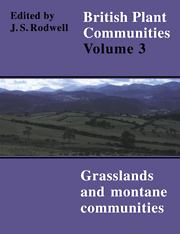Book contents
- Frontmatter
- Contents
- List of Figures
- Preface and Acknowledgements
- Preamble
- Mesotrophic Grasslands
- Community Descriptions
- Calcicolous Grasslands
- Community Descriptions
- Calcifugous Grasslands and Montane Communities
- Community Descriptions
- Index of Synonyms to Grasslands and Montane Communities
- Index of Species in Grasslands and Montane Communities
- Bibliography
MG4 - Alopecurus Pratensis-Sanguisorba Officinalis Grassland
Published online by Cambridge University Press: 04 July 2020
- Frontmatter
- Contents
- List of Figures
- Preface and Acknowledgements
- Preamble
- Mesotrophic Grasslands
- Community Descriptions
- Calcicolous Grasslands
- Community Descriptions
- Calcifugous Grasslands and Montane Communities
- Community Descriptions
- Index of Synonyms to Grasslands and Montane Communities
- Index of Species in Grasslands and Montane Communities
- Bibliography
Summary
Synonymy
Hay Meads Baker 1937; Fritillario-Alopecuretum pratensis Westhoff & den Held 1969 p.p.; Flood-Meadows Duffey et al. 1974; Alluvial meadows Ratcliffe 1977; Fritillario-Sanguisorbetum officinalis Page 1980.
Constant species
Alopecurus pratensis, Cerastium fontanum, Cynosurus cristatis, Festuca rubra, Filipendula ulmaria, Holcus lanatus, Lathyrus pratensis, Leontodon autumnalis, Lolium perenne, Plantago lanceolata, Ranunculus acris, Rumex acetosa, Sanguisorba officinalis, Taraxacum officinale agg., Trifolium pratense, T. repens.
Rare species
Fritillaria meleagris, Taraxacum fulgidum, T. haematicum, T. melanthoides, T. sublaeticolor, T. subundulatum, T. tame sense.
Physiognomy
The Alopecurus pratensis-Sanguisorba officinalis community has a species-rich and somewhat varied sward of grasses and herbaceous dicotyledons. Among the former, there is generally no single dominant and, by June, when most of the grasses are flowering, Festuca rubra, Alopecurus pratensis, Cynosurus cristatus and Lolium perenne may all be abundant with, less frequently and usually in smaller amounts, Holcus lanatus, Anthoxanthum odoratum, Dactylis glomerata and Trisetum flavescens. Many other grasses occur occasionally and some of these may attain local abundance (e.g. Bromus hordeaceus ssp. hordeaceus and Agrostis stolonifera) or be conspicuous by virtue of a dense tussock habit (e.g. Arrhenatherum elatius, Deschampsia cespitosa and Festuca arundinacea). Carex acutiformis is occasional and it may be abundant but other sedges (e.g. C. panicea and C. hirta) are less frequent and never prominent. Juncus articulatus and J. inflexus occur patchily at low frequency.
Herbaceous dicotyledons are always an important component of the herbage. When growth commences in April or May, rosette species such as Leontodon autumnalis, L. hispidus, Plantago lanceolata and Bellisperennis are often prominent in the short sward. Taraxacum officinale agg. is a constant and sometimes abundant member of the community and is often especially conspicuous at this time when flowering. Older stands have a rich and varied dandelion flora and a number of species seem to be confined to the community (Richards 1972). It is at this time, too, that the most renowned occasional of the vegetation, Fritillaria meleagris, makes a spectacular display with its flowers, occurring patchily in the sward or sometimes as extensive sheets.
By July, the grasses have generally been overtopped by Sanguisorba officinalis and Filipendula ulmaria, both of which, though especially the former, may be abundant. By this time, the vegetation forms a dense herbage up to 70 cm or more tall. Below, Trifolium pratense, T. repens, Ranunculus acris,
- Type
- Chapter
- Information
- British Plant Communities , pp. 56 - 59Publisher: Cambridge University PressPrint publication year: 1992

